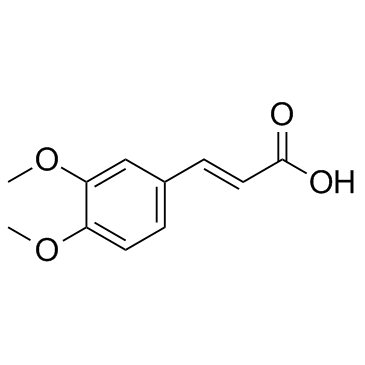3,4-Dimethoxycinnamic acid

3,4-Dimethoxycinnamic acid structure
|
Common Name | 3,4-Dimethoxycinnamic acid | ||
|---|---|---|---|---|
| CAS Number | 2316-26-9 | Molecular Weight | 208.211 | |
| Density | 1.2±0.1 g/cm3 | Boiling Point | 367.4±27.0 °C at 760 mmHg | |
| Molecular Formula | C11H12O4 | Melting Point | 181-183 °C(lit.) | |
| MSDS | USA | Flash Point | 144.0±17.2 °C | |
|
Biosynthesis of podophyllotoxin in Linum album cell cultures.
Planta 215(6) , 1031-9, (2002) Cell cultures of Linum album Kotschy ex Boiss. (Linaceae) showing high accumulation of the lignan podophyllotoxin (PTOX) were established. Enzymological studies revealed highest activities of phenylalanine ammonia-lyase, cinnamyl alcohol dehydrogenase, 4-hydr... |
|
|
[Preparation of derivatives of 3-(3,4-dimethoxyphenyl)propanic acid and a study of its biological activity].
Cesk. Farm. 39(3) , 109-12, (1990) From 3-(3,4-dimethoxyphenyl)propenic acid chloride and substituted amines and hydrazides, the appropriate amides and hydrazides (Table 1) were synthesized at 60-80 degrees C in the medium of benzene or toluene. The reaction of this chloride with benzaldehyde ... |
|
|
[Chemical constituents of Veronicastrum sibiricum (L.) Pennell].
Zhongguo Zhong Yao Za Zhi 17(1) , 35-6, 64, (1992)
|
|
|
[Pharmacological study on Veronicastrum sibiricum (L.) Pennell].
Zhongguo Zhong Yao Za Zhi 17(8) , 493-6, inside backcover, (1992) Six compounds were isolated from Veronicastrum sibiricum and identified as D-mannitol, beta-sitosterol, daucosterine, 3-0-acetyloleanolic acid, 3, 4-dimethoxy cinnamic acid and isoferulic acid. Pharmacological experiment has shown that isoferulic acid is anti... |
|
|
Absorption of dimethoxycinnamic acid derivatives in vitro and pharmacokinetic profile in human plasma following coffee consumption.
Mol. Nutr. Food. Res. 56(9) , 1413-23, (2012) This study reports the 24 h human plasma pharmacokinetics of 3,4-dimethoxycinnamic acid (dimethoxycinnamic acid) after consumption of coffee, and the membrane transport characteristics of certain dimethoxycinnamic acid derivatives, as present in coffee.Eight ... |
|
|
Determination of caffeine in coffee products by dynamic complexation with 3,4-dimethoxycinnamate and separation by CZE.
Electrophoresis 28(19) , 3570-4, (2007) A method based on the formation of pi-complexes with chlorogenate-like species was proposed for the determination of caffeine in regular (nondecaffeinated) and decaffeinated coffee. Both caffeate and 3,4-dimethoxycinnamate were able to transform caffeine--a n... |
|
|
Production of ligninolytic enzymes and synthetic lignin mineralization by the bird's nest fungus Cyathus stercoreus.
Appl. Microbiol. Biotechnol. 52(5) , 689-97, (1999) Production of ligninolytic enzymes and degradation of 14C-ring labeled synthetic lignin by the white-rot fungus Cyathus stercoreus ATCC 36910 were determined under a variety of conditions. The highest mineralization rate for 14C dehydrogenative polymerizates ... |
|
|
Polyamine levels in various tissues of rats treated with 3-hydroxy-4-methoxycinnamic acid and 3,4-dimethoxycinnamic acid.
Anticancer Drugs 7(8) , 866-72, (1996) The effects of 3-hydroxy-4-methoxycinnamic acid (3H4MCA) and 3,4-dimethoxycinnamic acid (3,4DMCA) on body weight, organ weight, and the contents of putrescine, spermidine and spermine in 15 different tissues were examined in rats that had been given these com... |
|
|
Antihepatotoxic activity and chemical constituents of Buddleja asiatica Lour.
Z. Naturforsch., C, J. Biosci. 64(1-2) , 11-9, (2009) A new natural compound, named 6-O-(3",4"-dimethoxycinnamoyl) catalpol, was isolated from the defatted alcoholic extract of the flowering parts of Buddleja asiatica Lour. (family Scrophulariaceae). Other separated known compounds included steroids (beta-sitost... |